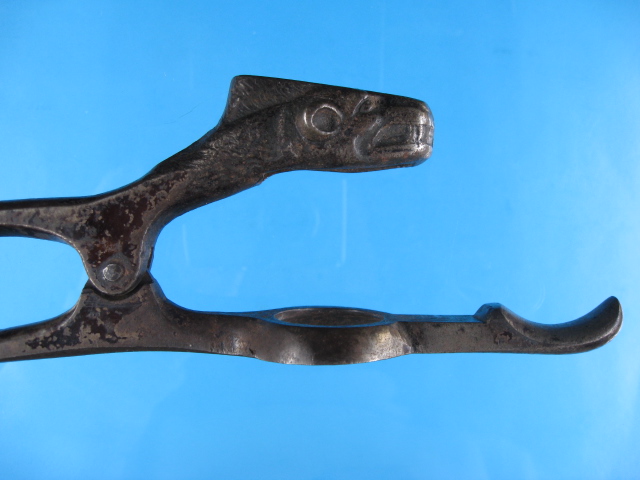Previously Unknown Clark Lever Corkscrew Variation?
In December 2011 an example of an extremely rare Clark lever corkscrew appeared for sale on eBay. The corkscrew is shown below:
The corkscrew differs significantly from other examples of Clark’s lever. An example of the previously known corkscrew is shown in the following image.
With the newly discovered variant, the worm is different, as is the animal head, described later. It is quite probable this corkscrew slipped by most collectors, as being rare, there aren’t many examples to compare with this variation.
The lever is almost certainly English. The corkscrew in the second image is marked T & C CLARK & Co and it seems highly likely this is the company at Shakespeare Foundry, founded in 1795 by Thomas and Charles Clark; it grew to be one of the largest iron foundries in Wolverhampton. http://www.localhistory.scit.wlv.ac.uk/Museum/metalware/Clark/ShakespeareFoundry.htm
There is no record of any Patent or Registered Design Protection existing for the Clark lever perhaps because there is a patent for a similar corkscrew granted in 1854 to Edward Burke.
Examples of this rare corkscrew are much heavier in construction than Lund type levers. The example in the first image is 205mm long (8”).The example in the second image is 230mm long (9”).The Clark’s lever is in many ways similar to French “Dordet” type levers that also have captive worms along with animal head decoration to the top lever arms.
Interestingly the Clark’s lever has a gold colour finish, which is probably some type of varnish, very different to the copper wash seen on many 19th century corkscrews. This finish can be seen clearly in the next image
The Clark consists of two lever arms made from steel with a central rivet or pivot joining the arms together. The upper arm has a “tiger” or “panthers” head with a slot in it, the corkscrew worm is loosely fitted in this slot. There are “ears” to the top of the worm that form a handle, these are consistent with the decorative animal head on the upper lever arm. The lower lever arm has a neck ring at one end with a hook like device at its extremity. This device is probably a wire breaker for removing wire from around corks.
OPERATION
To operate: Screw the worm into the cork using the “ears” to secure a good grip and close the two handles together securely, this action pulls the cork from the neck of the bottle. The cork can then be removed from the worm by turning.
The newly discovered lever is much prettier than the previously known corkscrew. As the image above shows the casting is much sharper and more detailed.
The long slot in the top of the animal’s head is much shorter making the head smaller from back to front thus making the variation more refined; these differences are very obvious when both lever variations are compared side by side.
In my opinion the new variation, the rarest of Clark’s levers, was made first and this is the only example I know of. I would be very interested to hear from anyone who has seen another example of this variation. Please contact me if you have any additional information that you think may be of interest.





